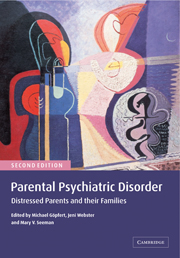Book contents
- Frontmatter
- Contents
- List of contributors
- Foreword
- Preface
- Part I Basic issues
- Part II Comprehensive assessment and treatment
- Part III Specific disorders: the impact on parent–child relationships
- 11 Schizophrenia and motherhood
- 12 When a parent suffers from an affective disorder: effect on the child
- 13 Alcohol and drug problems in parents: an overview of the impact on children and implications for practice
- 14 When mothers abuse drugs
- 15 Personality disorder in parents: developmental perspectives and intervention
- Part IV Specific treatments and service needs
- Part V Child-sensitive therapeutic interventions
- Part VI Models for collaborative services and staff training
- Afterword
- Index
- References
13 - Alcohol and drug problems in parents: an overview of the impact on children and implications for practice
from Part III - Specific disorders: the impact on parent–child relationships
Published online by Cambridge University Press: 09 August 2009
- Frontmatter
- Contents
- List of contributors
- Foreword
- Preface
- Part I Basic issues
- Part II Comprehensive assessment and treatment
- Part III Specific disorders: the impact on parent–child relationships
- 11 Schizophrenia and motherhood
- 12 When a parent suffers from an affective disorder: effect on the child
- 13 Alcohol and drug problems in parents: an overview of the impact on children and implications for practice
- 14 When mothers abuse drugs
- 15 Personality disorder in parents: developmental perspectives and intervention
- Part IV Specific treatments and service needs
- Part V Child-sensitive therapeutic interventions
- Part VI Models for collaborative services and staff training
- Afterword
- Index
- References
Summary
Alcohol and other drugs are used in socially acceptable ways in many diverse cultures but may, under some conditions, produce problems. Problem drinking/drug-taking is defined as any drinking or taking of drugs which causes problems to the drinker/drug-taker or to someone else. The majority of problem drinking/drug-taking is done by people who use alcohol or drugs inappropriately or in an unsafe or hazardous manner, as opposed to people who are seriously dependent or ‘addicted’.
How common is problem drink or drug use?
Figures for the year 2000 (Office for National Statistics, 2001) show that in the UK, 26% of adults report hazardous drinking patterns (as measured by the AUDIT questionnaire; Babor et al., 1992), and about 7% show symptoms of dependence on alcohol (as measured by the SADQ; Stockwell et al., 1983). Men are much more likely to report both hazardous drinking behaviour and signs of dependence than women: for hazardous drinking, the rates were 38% of men vs. 15% of women. Although these figures vary with age as well as gender, the prevalence rate for men never falls below 30% until the 60–64 age group, whereas the prevalence rate for women falls from around 30% for both the 16–19 and 20–24 age groups to around 24% in the 25–29 age group, and to below 20% thereafter.
These figures represent a large growth since the previous survey of this type in 1993.
- Type
- Chapter
- Information
- Parental Psychiatric DisorderDistressed Parents and their Families, pp. 185 - 202Publisher: Cambridge University PressPrint publication year: 2004
References
- 14
- Cited by

